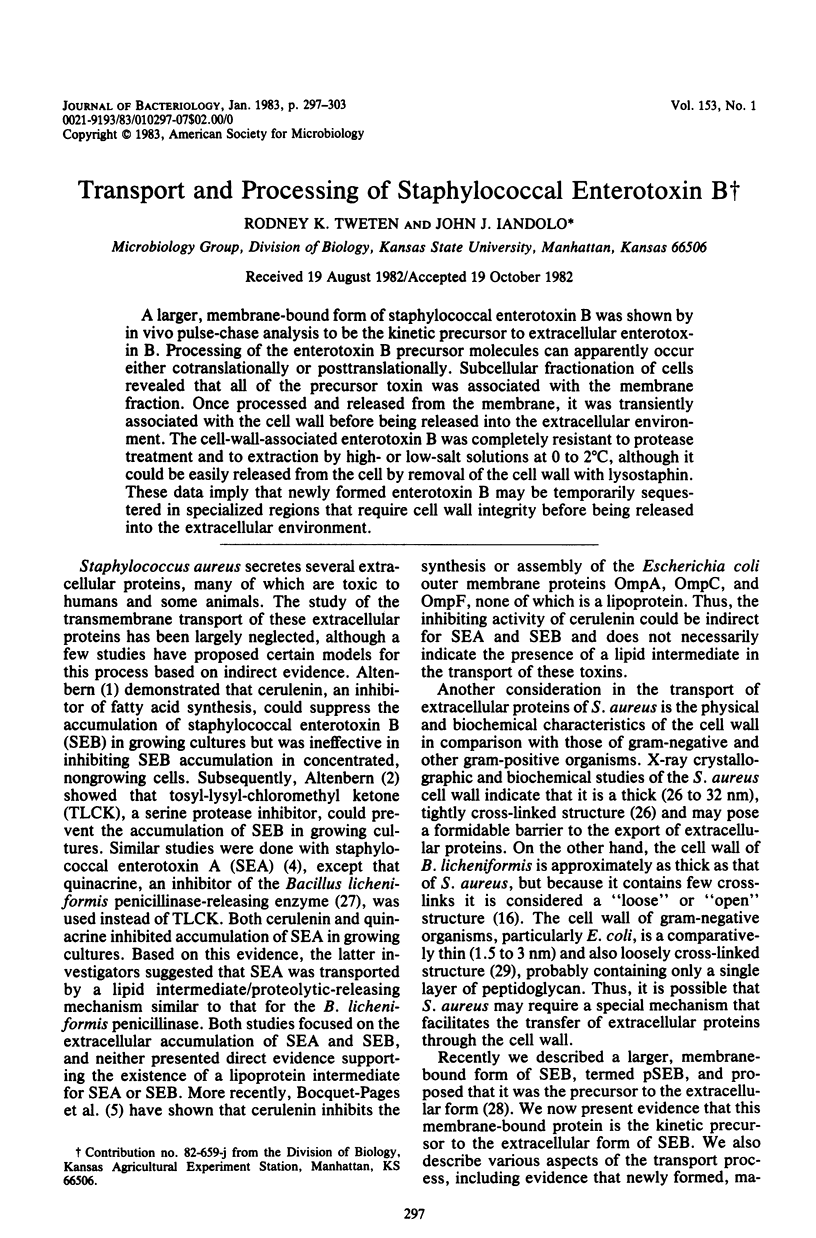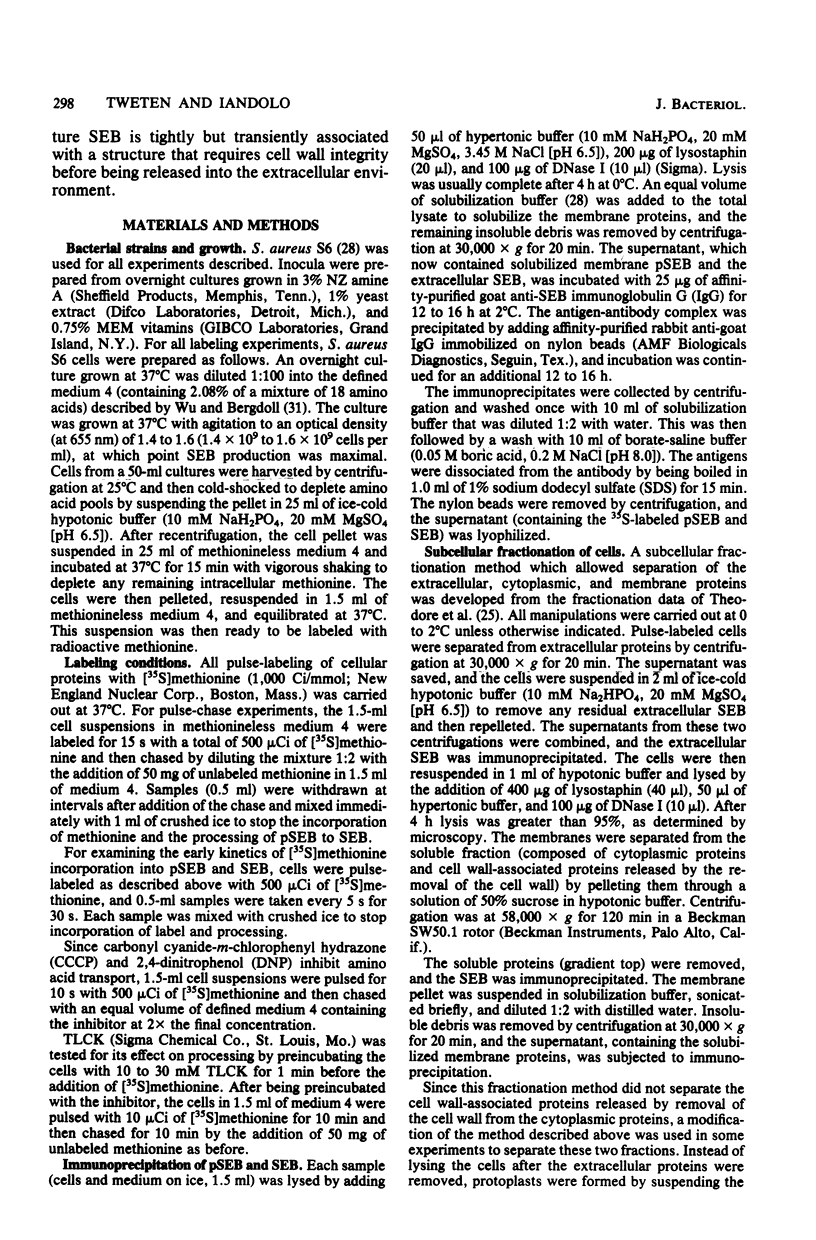Abstract
A larger, membrane-bound form of staphylococcal enterotoxin B was shown by in vivo pulse-chase analysis to be the kinetic precursor to extracellular enterotoxin B. Processing of the enterotoxin B precursor molecules can apparently occur either cotranslationally or posttranslationally. Subcellular fractionation of cells revealed that all of the precursor toxin was associated with the membrane fraction. Once processed and released from the membrane, it was transiently associated with the cell wall before being released into the extracellular environment. The cell-wall-associated enterotoxin B was completely resistant to protease treatment and to extraction by high- or low-salt solutions at 0 to 2 degrees C, although it could be easily released from the cell by removal of the cell wall with lysostaphin. These data imply that newly formed enterotoxin B may be temporarily sequestered in specialized regions that require cell wall integrity before being released into the extracellular environment.
Full text
PDF






Images in this article
Selected References
These references are in PubMed. This may not be the complete list of references from this article.
- Bocquet-Pages C., Lazdunski C., Lazdunski A. Lipid-synthesis-dependent biosynthesis (or assembly) of major outer-membrane proteins of Escherichia coli. Eur J Biochem. 1981 Aug;118(1):105–111. doi: 10.1111/j.1432-1033.1981.tb05491.x. [DOI] [PubMed] [Google Scholar]
- Bonner W. M., Laskey R. A. A film detection method for tritium-labelled proteins and nucleic acids in polyacrylamide gels. Eur J Biochem. 1974 Jul 1;46(1):83–88. doi: 10.1111/j.1432-1033.1974.tb03599.x. [DOI] [PubMed] [Google Scholar]
- Burge R. E., Adams R., Balyuzi H. H., Reaveley D. A. Structure of the peptidoglycan of bacterial cell wassl. II. J Mol Biol. 1977 Dec 25;117(4):955–974. doi: 10.1016/s0022-2836(77)80007-7. [DOI] [PubMed] [Google Scholar]
- Czop J. K., Bergdoll M. S. Synthesis of Enterotoxin by L-Forms of Staphylococcus aureus. Infect Immun. 1970 Feb;1(2):169–173. doi: 10.1128/iai.1.2.169-173.1970. [DOI] [PMC free article] [PubMed] [Google Scholar]
- Daniels C. J., Bole D. G., Quay S. C., Oxender D. L. Role for membrane potential in the secretion of protein into the periplasm of Escherichia coli. Proc Natl Acad Sci U S A. 1981 Sep;78(9):5396–5400. doi: 10.1073/pnas.78.9.5396. [DOI] [PMC free article] [PubMed] [Google Scholar]
- Date T., Goodman J. M., Wickner W. T. Procoat, the precursor of M13 coat protein, requires an electrochemical potential for membrane insertion. Proc Natl Acad Sci U S A. 1980 Aug;77(8):4669–4673. doi: 10.1073/pnas.77.8.4669. [DOI] [PMC free article] [PubMed] [Google Scholar]
- Date T., Zwizinski C., Ludmerer S., Wickner W. Mechanisms of membrane assembly: effects of energy poisons on the conversion of soluble M13 coliphage procoat to membrane-bound coat protein. Proc Natl Acad Sci U S A. 1980 Feb;77(2):827–831. doi: 10.1073/pnas.77.2.827. [DOI] [PMC free article] [PubMed] [Google Scholar]
- Enequist H. G., Hirst T. R., Harayama S., Hardy S. J., Randall L. L. Energy is required for maturation of exported proteins in Escherichia coli. Eur J Biochem. 1981 May 15;116(2):227–233. doi: 10.1111/j.1432-1033.1981.tb05323.x. [DOI] [PubMed] [Google Scholar]
- Forsgren A., Forsum U., Hallander H. O. Failure to detect cell-associated enterotoxin B in Staphylococcus aureus by immunofluorescence. Appl Microbiol. 1972 Mar;23(3):559–564. doi: 10.1128/am.23.3.559-564.1972. [DOI] [PMC free article] [PubMed] [Google Scholar]
- Friedman M. E. Inhibition of staphylococcal enterotoxin B formation by cell wall blocking agents and other compounds. J Bacteriol. 1968 Mar;95(3):1051–1055. doi: 10.21236/ad0833372. [DOI] [PMC free article] [PubMed] [Google Scholar]
- Garwin J. L., Beckwith J. Secretion and processing of ribose-binding protein in Escherichia coli. J Bacteriol. 1982 Feb;149(2):789–792. doi: 10.1128/jb.149.2.789-792.1982. [DOI] [PMC free article] [PubMed] [Google Scholar]
- Hughes R. C. Autolysis of isolated cell walls of Bacillus licheniformis N.C.T.C. 6346 and Bacillus subtilis Marburg Strain 168. Separation of the products and characterization of the mucopeptide fragments. Biochem J. 1970 Oct;119(5):849–860. doi: 10.1042/bj1190849. [DOI] [PMC free article] [PubMed] [Google Scholar]
- Josefsson L. G., Randall L. L. Processing in vivo of precursor maltose-binding protein in Escherichia coli occurs post-translationally as well as co-translationally. J Biol Chem. 1981 Mar 10;256(5):2504–2507. [PubMed] [Google Scholar]
- Laemmli U. K. Cleavage of structural proteins during the assembly of the head of bacteriophage T4. Nature. 1970 Aug 15;227(5259):680–685. doi: 10.1038/227680a0. [DOI] [PubMed] [Google Scholar]
- Mbikay M., Garrick M. D. Inhibition of initiation of protein synthesis by tosyl-L-lysyl chloromethyl ketone. Can J Biochem. 1981 May;59(5):321–327. doi: 10.1139/o81-045. [DOI] [PubMed] [Google Scholar]
- Rossman T., Norris C., Troll W. Inhibition of macromolecular synthesis in Escherichia coli by protease inhibitors. Specific reversal by glutathione of the effects of chloromethyl ketones. J Biol Chem. 1974 Jun 10;249(11):3412–3417. [PubMed] [Google Scholar]
- Short S. A., Kaback H. R. Amino acid transport and staphylococcal membrane vesicles. Ann N Y Acad Sci. 1974 Jul 31;236(0):124–143. doi: 10.1111/j.1749-6632.1974.tb41487.x. [DOI] [PubMed] [Google Scholar]
- Smith W. P., Tai P. C., Davis B. D. Interaction of secreted nascent chains with surrounding membrane in Bacillus subtilis. Proc Natl Acad Sci U S A. 1978 Dec;75(12):5922–5925. doi: 10.1073/pnas.75.12.5922. [DOI] [PMC free article] [PubMed] [Google Scholar]
- Smith W. P., Tai P. C., Davis B. D. Nascent peptide as sole attachment of polysomes to membranes in bacteria. Proc Natl Acad Sci U S A. 1978 Feb;75(2):814–817. doi: 10.1073/pnas.75.2.814. [DOI] [PMC free article] [PubMed] [Google Scholar]
- Theodore T. S., Popkin T. J., Cole R. M. The separation and isolation of plasma membranes and mesosomal vesicles from Staphylococcus aureus. Prep Biochem. 1971;1(3):233–248. doi: 10.1080/00327487108081942. [DOI] [PubMed] [Google Scholar]
- Tipper D. J., Berman M. F. Structures of the cell wall peptidoglycans of Staphylococcus epidermidis Texas 26 and Staphylococcus aureus Copenhagen. I. Chain length and average sequence of cross-bridge peptides. Biochemistry. 1969 May;8(5):2183–2192. doi: 10.1021/bi00833a060. [DOI] [PubMed] [Google Scholar]
- Traficante L. J., Lampen J. O. Vesicle penicillinase of Bacillus licheniformis: existence of periplasmic-releasing factor(s). J Bacteriol. 1977 Jan;129(1):184–190. doi: 10.1128/jb.129.1.184-190.1977. [DOI] [PMC free article] [PubMed] [Google Scholar]
- Tweten R. K., Iandolo J. J. Purification and partial characterization of a putative precursor to staphylococcal enterotoxin B. Infect Immun. 1981 Dec;34(3):900–907. doi: 10.1128/iai.34.3.900-907.1981. [DOI] [PMC free article] [PubMed] [Google Scholar]
- Van Heijenoort J., Elbaz L., Dezélée P., Petit J. F., Bricas E., Ghuysen J. M. Structure of the meso-diaminopimelic acid containing peptidoglycans in Escherichia coli B and Bacillus megaterium KM. Biochemistry. 1969 Jan;8(1):207–213. doi: 10.1021/bi00829a030. [DOI] [PubMed] [Google Scholar]
- Watts C., Silver P., Wickner W. Membrane assembly from purified components. II. Assembly of M13 procoat into liposomes reconstituted with purified leader peptidase. Cell. 1981 Aug;25(2):347–353. doi: 10.1016/0092-8674(81)90053-2. [DOI] [PubMed] [Google Scholar]
- Wu C. H., Bergdoll M. S. Stimulation of Enterotoxin B Production II. Synthetic Medium for Staphylococcal Growth and Enterotoxin B Production. Infect Immun. 1971 Jun;3(6):784–792. doi: 10.1128/iai.3.6.784-792.1971. [DOI] [PMC free article] [PubMed] [Google Scholar]






